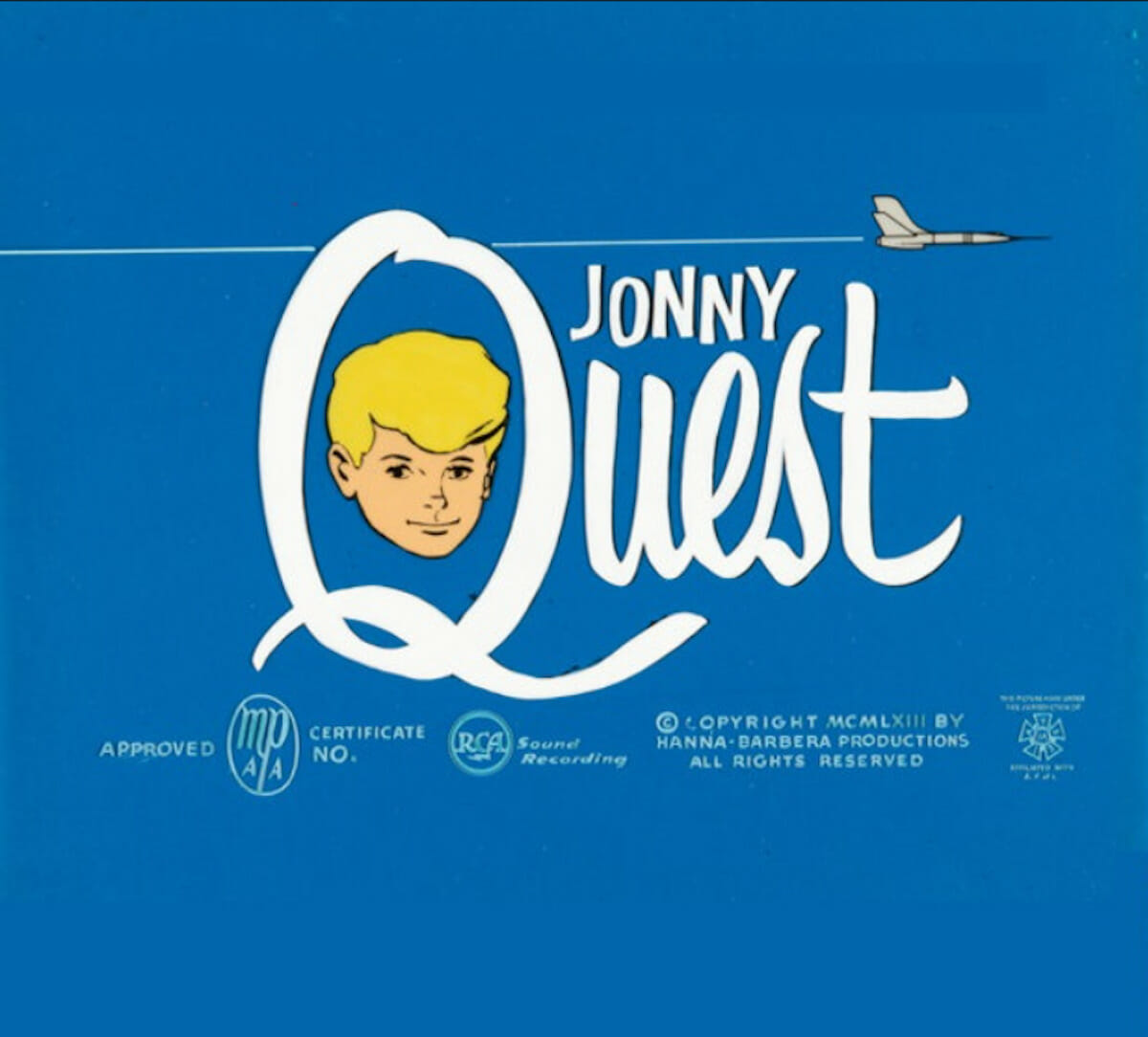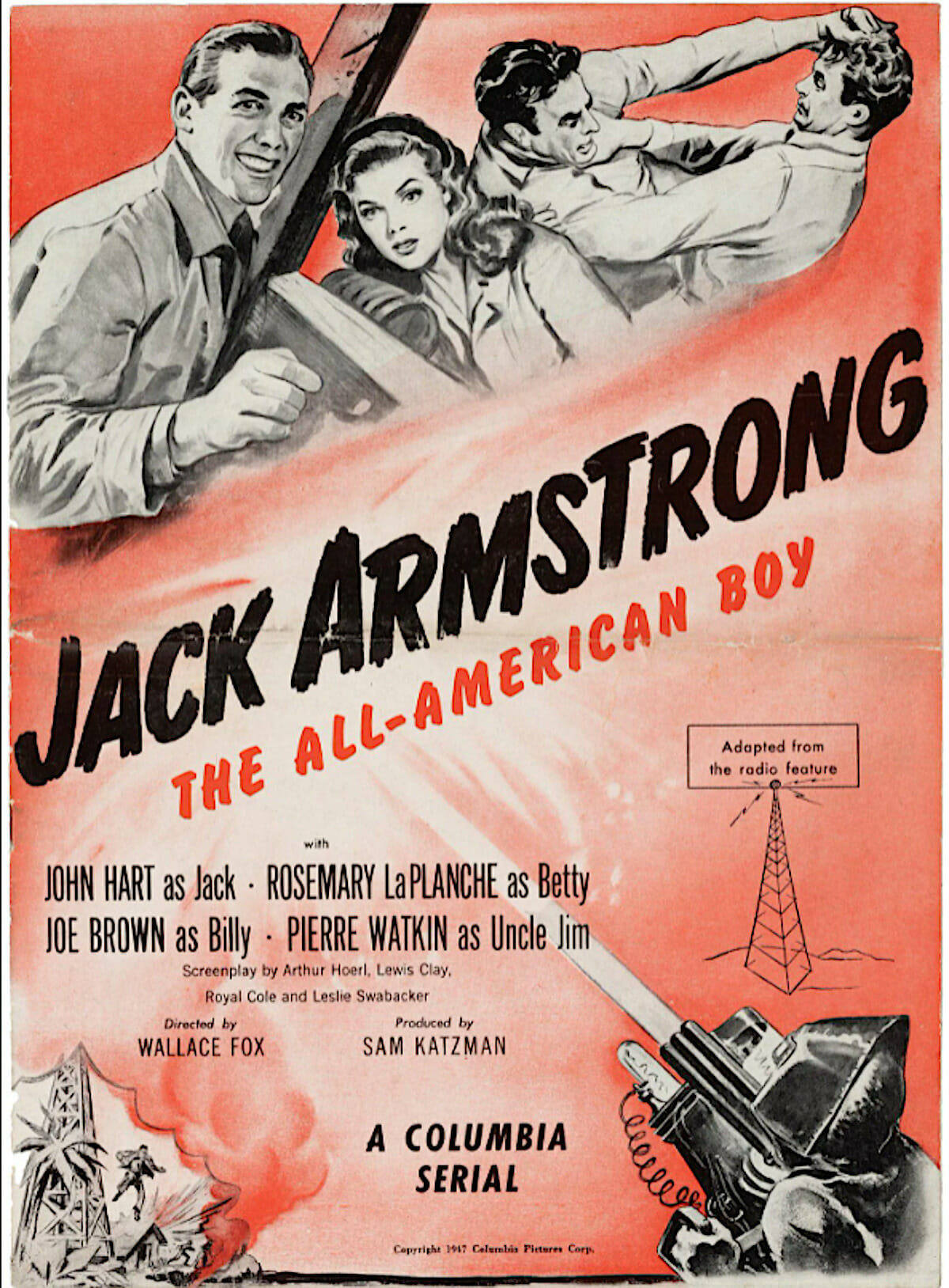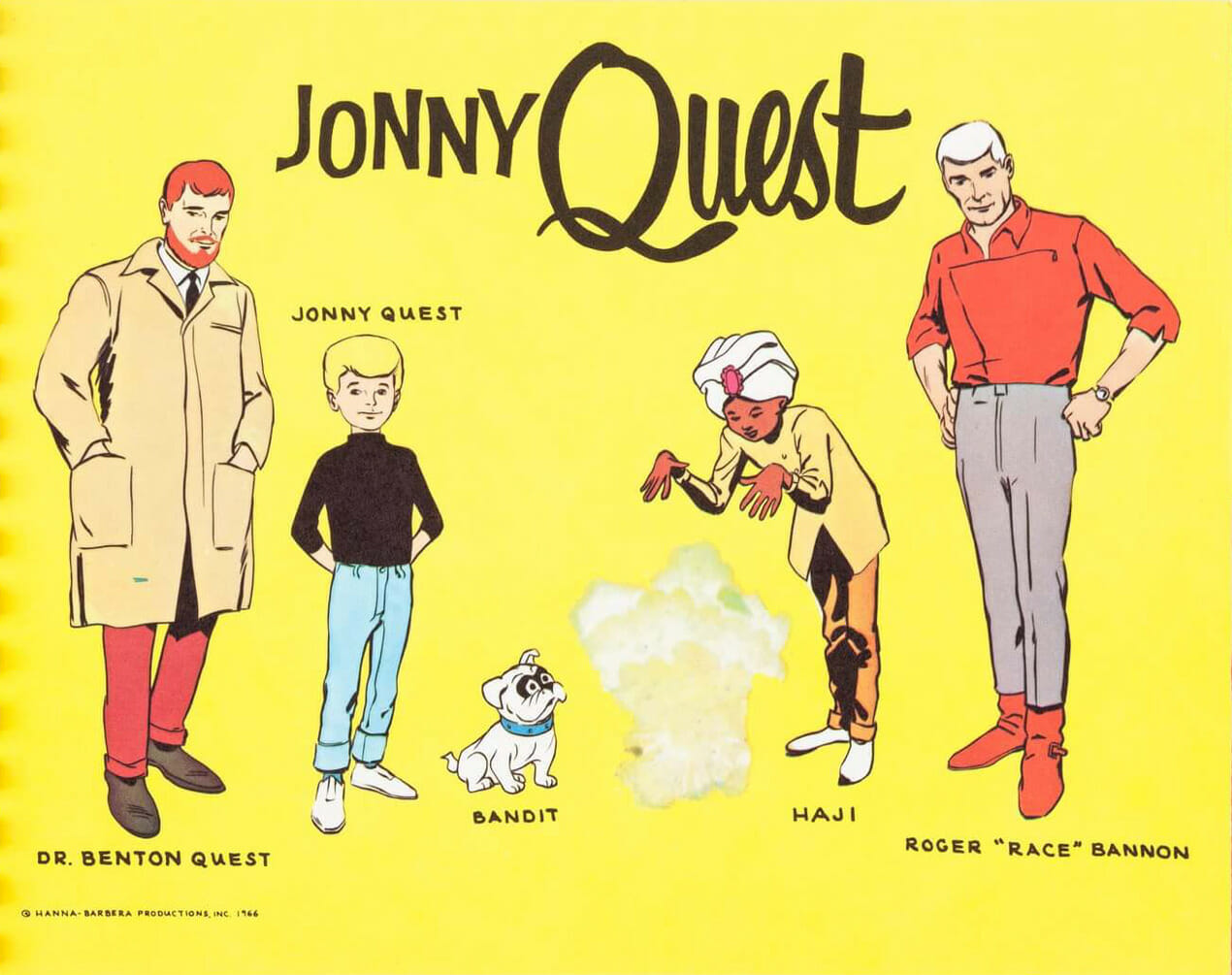Ah, Saturday morning cartoons. In the 1960s and ‘70s, it was an oasis from the cruelty and trivial violence of our school week: the brusque reprimands of teachers, the grubby hands of schoolyard bullies, the principal’s paddle.
An oasis with machine guns and laser beams and – instead of our schools’ authority figures – the sinister plans of would-be-world-dominator evil scientists.
Sure, there was a lot of whimsical action and bears that always bragged they were smarter than average, but Saturday morning cartoons’ hallmark was action – and the king of that action was a pre-teen named Jonny Quest, who lived his adventurous life first on primetime and then on Saturday morning.
For this article, I tried to count the number of shots fired in the opening credits of Jonny Quest. “I can do this,” I thought before I mashed the play button. “There’s the soldiers firing and then Race Bannon firing and …”
But when I actually watched, I couldn’t keep track. There are a lot of shots fired in the opening credits of the 1964 animated series. There are the soldiers with machine guns firing at the robot spy. Then guys in elaborate helmets and masks firing their own automatic weapons. And then Race Bannon firing his rifle. Even in my head, having seen the show and its credits recently, I didn’t remember so many shots were fired in the opening credits.
There’s too much shooting to get an accurate picture unless you go frame-by-frame, and for the purposes of this story, I didn’t need to do that. If a show is so violent you can’t count the number of shots fired in the opening credits – not to mention the tank fire and two different kinds of large-scale ray guns, cribbed from two different episodes, and two bad guys crushed beneath a speed boat in the end credits – you can just chalk it up as a violent show.
Maybe the most violent children’s show ever.
But don’t worry. I’m here to praise Jonny Quest, not bury it.

We have to acknowledge that Jonny Quest is a product of its time. In 1964, when the show aired for a single season on the ABC network, violence in television series – even those watched by children – was pretty common. The Man from UNCLE, a Bond variation, was in primetime. Gunsmoke’s credits depicted the marshal of Dodge City killing a man in a gunfight.
Aside from its violence, Jonny Quest was remarkably matter of fact in its presentation of a blended family, as Hadji Singh was plainly adopted by Dr. Benton Quest and was in effect the brother to Jonny. And they were tutored and protected by Race Bannon, a government agent assigned to protect the family from enemy countries.
But the other tropes for characters outside the nuclear Quest family are pretty deplorable. Native people are inevitably dark, stereotypically thick-accented, cowardly, superstitious or criminal masterminds like Dr. Zin. And women are few and far between, with the notable exception of Jade, Race’s old girlfriend and fellow adventurer.
Viewing the show through the filter of time and great leaps in enlightenment in our culture makes it hard to accept the show as anything but hopelessly out of date.
And then there’s the violence.
“Although Jonny Quest is high adventure, which always means the presence of villains, there will be no violence. Villains will be disposed of in imaginative, clever ways, rather than violent, the creators emphasize.”
This paragraph in the Daily Courier of Bristol, Penn., on Aug. 22, 1964, is a hell of an example of a newspaper writer accepting the word of a creator at face value. The show was still nearly a month from its Sept. 18 debut and I’m guessing the writer didn’t get to screen an episode or two before writing the story.
There’s more: “It’s easy to whip out a gun and shoot a villain, says Joe Barbera. It’s much more difficult and challenging to find unique escape methods. Some of our tricks will remind the adults in our audience of the old Doug Fairbanks Sr. methods, which always had a touch of humor about them.”
Joe Barbera, whose Hanna-Barbera Productions made some of the most iconic animated shows of the 1960s, like Jonny Quest, Yogi Bear, The Flintstones and many more, was making a point with that Douglas Fairbanks reference. Fairbanks was still remembered at that point for starring in silent film swashbucklers like The Mark of Zorro and The Three Musketeers.
But the inspiration for Jonny Quest was more contemporary and more violent entertainment and included the James Bond stories and films, as well as classic boys adventure stories and newspaper comic strips.

The Flintstones had been a primetime TV hit and Hanna-Barbera wanted an animated adventure story. The company contacted Doug Wildey, an artist, about producing a show based around Jack Armstrong, the All-American Boy, a radio adventure series that ran for nearly 20 years, until 1951, and spawned shorter-lived film, book and comic book series.
As Wildey recounts in a lengthy interview in a 1986 issue of Amazing Heroes magazine, Hanna-Barbera dropped the idea of adapting the Jack Armstrong character and asked him to create an original adventure series and character.
Wildey cites his influences, including adventure stories featuring young people and adults getting into scrapes, such as Treasure Island, as well as Terry and the Pirates, a newspaper comic adventure strip from artist Milton Caniff that ran from 1934 to 1973. Barbera had seen the movie version of the James Bond adventure Dr. No and wanted some elements of the kind of globe-trotting adventure the Bond stories specialized in.
Wildey masterminded the story of Benton Quest, a high-level government scientist with an 11-year-old son, Jonny. Jonny’s mother had been killed – presumably by foreign agents – and the government placed Roger “Race” Bannon in the Quests’ household. Bannon acts as both tutor and bodyguard for Jonny and Hadji Singh, also 11, an orphan from the streets of Kolkata who was adopted by Benton Quest.
As anyone who has seen the great parody Adult Swim episode of Harvey Birdman: Attorney at Law about the custody battle between Benton Quest and Race Bannon knows, the four – and Jonny’s bulldog, Bandit – quickly become a nuclear family and jet all over the world for adventures in the original series’ 26 episodes, which aired from September 1964 to March 1965.
The Quest team encountered evil masterminds like Dr. Zin, evil masterminds that kept murderous Komodo dragons, evil masterminds that kept a pet Pteranodon … well, you get the idea. The solution to all this evil often resulted in Race Bannon punching out a beefy lackey or Benton Quest inventing a new weapon of mass destruction or Jonny, Hadji and Bandit avoiding venomous creatures and, in an episode laden with problematic representation, a mummy. All set to Hoyt Curtin’s jazzy score.
How violent was Jonny Quest? In 2017, the website Evil Bob Day Job did a variation on what I wasn’t willing to do: I didn’t count shots fired in the opening credits, but Evil Bob Day Job watched every episode and declared that 145 people were killed in the original series.
The opening credits and all that machine-gunning only teased the mayhem that was to follow, obviously. In the pilot, Mystery of the Lizard Men – in a shot used in the end credits every week – Race literally obliterates a couple of murderous bad guys by slamming his speedboat on top of theirs. There’s a quick look of horror from the bad guys and then they and their boat disappear beneath Race’s vessel.
And while I’ve cited the many, many shootings, it’s probably the case that more people die in explosions in Jonny Quest than by any other means. It’s not as if body parts are strewn around – the series is bloodless, as you might expect, despite all the violence – but damn the series was creative not only with explosions but attacks by tigers, leopards, Pteranodons and invisible monsters.
Although it’s not likely showing us a fatal attack, one scene that gave me pause even as a kid was from The Robot Spy, when the titular character approaches a solder and quickly ejects a large suction cup that connects wetly with the soldier’s forehead, causing him to crumple to the floor.
The series ended with cancellation, but that wasn’t the end of Jonny Quest and it wasn’t the end of arguments over the show’s level of violence.
Song of the South and more
In the 1960s and 1970s, comic books and cartoons were for kids, right? And surely there could be nothing scandalous about that kiddie fodder?
As long as art has existed, there’s been censorship, and that applies to cartoons too. Usually the censorship was self-censorship and well-meaning, as Disney’s decision to relegate its 1946 film Song of the South to the Disney vault.
The film was rightly targeted for its outdated and racist characterizations even as it was released. The NAACP said the film had artistic merit but said the movie “helps to perpetuate a dangerously glorified picture of slavery.” Other prominent figures and organizations agreed. The film was re-released most recently in 1986 – during a period when Disney re-released each of their films every few years – but has never been released on home video in the United States.
Because white men have long dominated Hollywood, the fodder for culturally insensitive animation has always been there. Disney’s chief competitor in animation was Warner Bros., creators of Bugs Bunny and Daffy Duck. Many Warner Bros. cartoons look, in retrospect, horrifying in terms of racial stereotyping. Confederate Honey, a Bugs Bunny short originally released in 1940, included Bugs and Elmer Fudd in blackface and singing Camptown Races.
There’s an entire group of Warner Bros. cartoon shorts that have never been re-released or released on home video because of stereotypical content. The so-called “Censored Eleven” cartoons are among the best known of those.
In many of the action-adventure cartoons produced by Hanna-Barbera, conflict was usually not resolved by some Douglas-Fairbanks-style daring escape. Most often, it was resolved by an exchange of powerful rays streaming out of Space Ghost’s hands or from Birdman and the Galaxy Trio’s fists. (And yes, it’s more or less the same Birdman so deftly resurrected for parody decades later.)
MGM’s Tom and Jerry – created in 1940 by William Hanna and Joe Barbera, interestingly enough – waged a cat-and-mouse war through 161 animated shorts released to theaters. The duo dabbled in blackface, unfortunately, but were best known for the mayhem that inspired the cartoon characters Itchy and Scratchy on The Simpsons.
The Daily Mail noted in 2013 that two Tom and Jerry shorts would not be included on an upcoming Blu-Ray collection because of blackface scenes. But all that cat-on-mouse and mouse-on-cat violence captured the attention of critics and Hanna-Barbera created new Tom and Jerry cartoons in 1975 that toned down the violence. In the 2000s, the cartoons were edited to remove scenes of characters smoking.
In hindsight, judicious editing of what’s now recognized as objectionable or harmful material is appropriate, and there are now options, online and elsewhere, for people to see the unexpurgated originals if they wish.
The editing of Jonny Quest for violence, however, seems odd and random. When the series originally aired, I was too young to have seen it, or if I did, I don’t remember it. It wasn’t until the late 1960s and 1970s and Quest reruns on Saturday mornings on CBS and NBC that I remember being struck by the clumsy editing of the violent scenes.
In a scene in which a sniper fires a rifle at another character, the cartoon showed the sniper raising the rifle and then an abrupt cut to the second character slumping, presumably dead or at least wounded. If there had been blood – and for decades cartoon violence was bloodless – it would have been cut too.
A few years later, Quest was again edited, although this time for controversial dialogue.
When the series was released on disc in 2004, several lines of dialogue were cut. The cuts included Race Bannon taunting native enemies by saying things like “ignorant savages” and “heathen monkeys.” In 2019, for the Blu-Ray release, Warner Archive Collection promised uncut versions “as originally first broadcast in prime time on ABC during the 1964-1965 season.” I can’t verify if the episodes were really uncut.
As we’ve seen, it’s easier to cut racially insensitive dialogue and attitudes and the most obvious incidents of violence, but as with Song of the South, sometimes it’s easier to just remove the problem from public view entirely.
Tracing the line from Jonny to Indy
“We’re glad we can introduce today’s youngsters to the pure type of adventure stories we grew up on,” Bill Hanna said in that August 1964 story in which Joe Barbera promised Jonny Quest would not be violent.
It’s possible, just possible, that some people were skeptical of Hanna and Barbera’s good intentions. Over the last half of the 1960s, voices were increasingly raised about violence in animated shows, including and in particular Jonny Quest.
In January 1972, The New York Times reported on the release of the Surgeon General’s report on the effects of TV violence on children. About the report, the Times wrote, “It said that the majority of children were not adversely affected by TV violence although some youngsters, predisposed by other factors to aggressiveness, might be influenced.”
The report said cartoons were the most violent types of programs from 1967 to 1969. The article went on to cite Aquaman, Spider-Man, Superman, The Herculoids and The Fantastic Four. Spurred by concerns of groups like Action for Children’s Television, networks had by 1972 largely removed the most violent shows from their schedules.

The article cited Jonny Quest, “which ACT considers one of the most violent programs on network television.” Oddly, the article notes indications that Quest would not be back. Considering that the series ended its primetime run seven years earlier, I think that was a possibility.
Jonny Quest did come back, of course, in edited reruns on Saturday mornings in the 1970s. Eventually a sequel series was syndicated but it was no equal to the original. And none of the multiple announcements of any Jonny Quest live-action movies have come about.
Years later, in 1990, the Children’s Television Act was enacted and overseen by the Federal Communications Commission with an eye toward adding more of an educational element to programming for children.
By that point, several years had passed since Steven Spielberg’s Raiders of the Lost Ark had revitalized the swashbuckling old stories that Hanna and Barbera cited back in 1964. When Harrison Ford’s adventurer, too tired to fight a hulking swordsman, pulls out his pistol and plugs the enemy, it was a funny and thrilling scene.
I’ve never noticed that moment cut for subsequent viewings. Maybe it’s because it wasn’t animated.